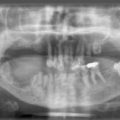Image guidance
Megavoltage imaging to verify patient set-up and the location of critical tissue in relation to the radiation field has been carried out for many years with slow film. Because of the poor contrast between soft tissue and bony anatomy at megavoltage energies, attempts were often made to add filtration to the film cassettes to enhance the image contrast. Custom film holders, which could be treated as an accessory, were also made available to facilitate such imaging at any angle of the gantry. Over the past 20 years, electronic systems for both planar and CT imaging of the patient have become available. This development, along with the move to reduce treatment margins on fields, to reduce the dose to critical tissue and increase the dose to the tumour, has, in the interest of accuracy, expanded the role of imaging in radiotherapy. Indeed, it has become such an essential part of the treatment process that linear accelerators are now always supplied with an on-board imaging device.
Stay updated, free articles. Join our Telegram channel

Full access? Get Clinical Tree




